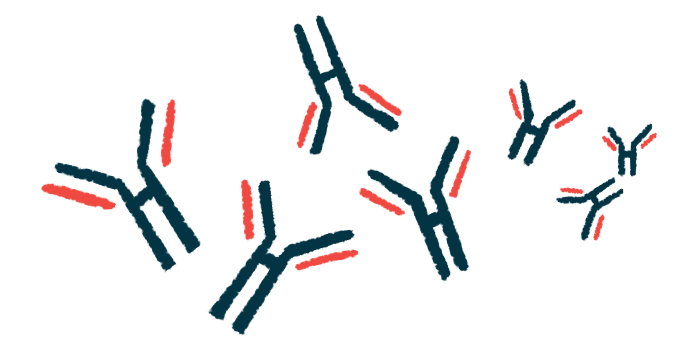IVIG effective treatment option for select AAV patients: Real-life study
Intravenous immunoglobulin use aids group largely resistant to other therapies

Intravenous immunoglobulin (IVIG) therapy appears to be an effective and relatively safe option for people with ANCA-associated vasculitis (AAV), according to real-life study of its use in Spain.
All of its 28 AAV patients were resistant to conventional treatments and/or had — or were suspected of having — an infection, the researchers noted.
The study, “Intravenous immunoglobulin therapy in antineutrophil cytoplasmic antibody-associated vasculitis,” was published in the European Journal of Internal Medicine.
AAV relapse or treatment-resistant disease identified in most given IVIG
AAV is a group of autoimmune diseases characterized by inflammation and damage to small blood vessels. Typically, the disease is caused by ANCAs, self-reactive antibodies that most commonly target one of two proteins, proteinase 3 (PR3) or myeloperoxidase (MPO), in a type of immune cell called neutrophils.
AAV treatment is planned in two stages. The first to induce remission, usually using a combination of glucocorticoids with other agents that suppress the immune system, such as cyclophosphamide and rituximab.
The second stage, aiming to maintain remission and prevent relapses, usually involves the combination of low-dose glucocorticoids and other immunosuppressive treatments, such as azathioprine and methotrexate.
However, the use of immunosuppressive agents increases the risk of severe side effects, such as infections, prompting a search for safer alternatives for patients at higher risk of infection or those ineligible for immunosuppressive treatment.
IVIG therapy consists of the into-the-vein administration of a pool of antibodies obtained from the blood of healthy donors. This approach can be used to neutralize the harmful antibodies that drive autoimmune conditions such as AAV.
The American College of Rheumatology’s 2021 recommendations for AAV management consider that IVIG can be used to control microscopic polyangiitis (MPA) or granulomatosis with polyangiitis (GPA) — the two main AAV types — while waiting for remission induction therapy to become effective.
“Although the data in the literature are still scarce, there are some clinical studies, most of them retrospective, about the use of IVIG for the treatment of AAV with promising results,” the researchers wrote.
To assess IVIG therapy’s safety and effectiveness in AAV within the clinical setting, researchers in Spain retrospectively analyzed data covering 28 people diagnosed with AAV from January 2000 to December 2022, given IVIG at a single Spanish center.
These 15 men and 13 women had a mean age of 57.1. The most frequent type was GPA (53.6%), followed by MPA (35.7%) and eosinophilic granulomatosis with polyangiitis (10.7%), the rarest AAV type.
MPO-ANCA antibodies were detected in 12 patients (42.8%), while PR3-ANCA antibodies were present in 11 patients (39.3%). In five patients (17.8%), there were no ANCA antibodies.
AAV remission seen in 56.5% of patients at two years
Before IVIG therapy, 23 (82.1%) had received at least one conventional treatment, most commonly oral glucocorticoids (75%), followed by into-the-vein methylprednisolone (a type of glucocorticoid; 46.4%), cyclophosphamide (46.4%), and methotrexate (21.4%).
IVIG was used due to disease relapse or treatment-resistant disease in 25 cases, the presence or suspicion of infection in three patients, and for both reasons in five cases. In most cases (67.8%), the treatment was administered in combination with other therapies, most commonly glucocorticoids. Nine patients received IVIG alone (32.1%).
IVIG was given at a dose of 2 g/kg, split over two, four, or five days.
After a mean follow-up of two years, 22 out of 26 patients (84.6%) reported no symptoms after the first month since IVIG therapy initiation.
The rate of AAV remission increased from 34.6% in the first month to 56.5% in two years, and disease severity, as assessed with the Birmingham Vasculitis Activity Score, was lower across all AAV types.
“None of the patients suffered severe deterioration of [kidney] function,” the researchers wrote, adding that markers of inflammation also significantly reduced over time.
In addition, 60% of the patients who tested positive for ANCAs at the beginning of the study became negative for these antibodies.
IVIG treatment was generally safe. Three patients experienced mild side effects, including headache, high blood pressure, and skin reaction. One developed heart failure that led to treatment discontinuation.
Three patients died, one due to multiorgan failure, one due to a severe evolution of the disease, and another of unknown causes.
This study suggests that “IVIG treatment may be useful to achieve and maintain the remission in certain patients with this type of vasculitis, being an advantageous therapeutic alternative in cases of concomitant infection or in patients who cannot receive conventional therapy,” the researchers wrote.
Among the study’s limitations, the team highlighted the alterations of diagnostic methods and treatments during the study period. They noted, however, that the inclusion of a significant number of patients from a single center contributed to some uniformity in the analysis of data.







